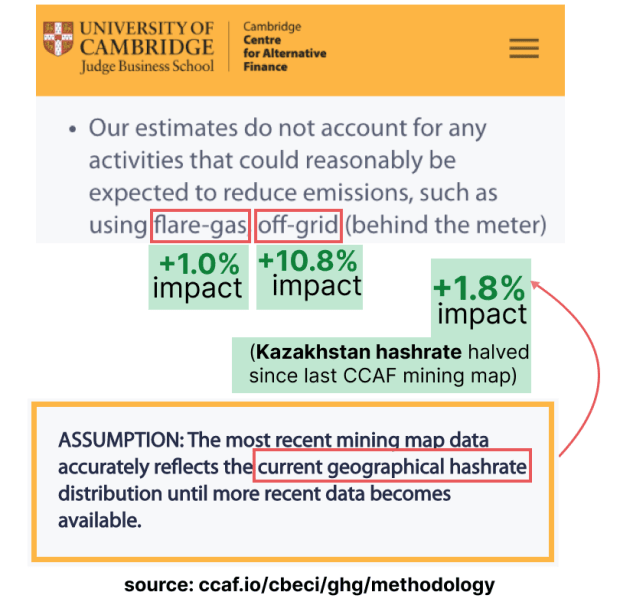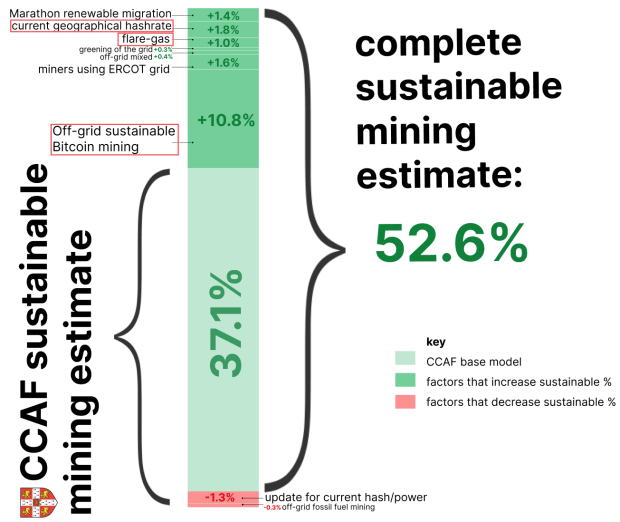Opposite to a misguided Cambridge College research, Bitcoin mining leverages 52.6% sustainable power, making it an interesting ESG funding.
This text offers a take a look at my newest analysis, revealing the way it got here to be {that a} 2022 Cambridge Centre For Various Finance’s (CCAF) research on Bitcoin’s environmental impression underestimates the quantity of sustainable Bitcoin mining happening. I additionally handle why we may be very assured that the precise sustainable power utilization is a minimum of 52.6% of Bitcoin mining’s whole power use.
Why This Issues
No matter your place on ESG funding, the truth is that it’s hovering, on monitor to achieve $10.5 trillion within the U.S. alone. What’s additionally true is that Bitcoin adoption can’t happen except this $10.5 trillion of ESG funds feels comfy that Bitcoin is a internet constructive to the setting.
Proper now, ESG buyers largely don’t really feel comfy that that is the case. In talking with them, my impression is that one purpose for ESG investor discomfort with Bitcoin is that the CCAF research, “A Deep Dive Into Bitcoin’s Environmental Affect,” reported that Bitcoin makes use of solely 37.6% sustainable power.
Whereas ESG buyers are usually fast to dismiss the work of Bitcoin-critic Alex de Vries — debunked in an earlier Bitcoin Journal article — I’ve discovered they’re additionally extra more likely to belief the CCAF research over a Bitcoin Mining Council (BMC) research that discovered Bitcoin makes use of 58.9% sustainable power. You possibly can perceive why: The Cambridge model says “respected, unbiased analysis,” whereas BMC’s says, “business physique.”
Mockingly, being an business physique, the very factor that offers BMC entry to real-time Bitcoin mining information, additionally made its findings simpler for a minimum of some ESG buyers to disqualify. Environmental teams akin to Earth Justice and journals akin to “The Ecologist” have been equally fast to imagine the CCAF numbers should be the proper ones.
So far, Bitcoiners have had a muted response. The outcome: The dialog about ESG funds getting behind Bitcoin can’t progress. Bitcoin person adoption stalls.
In the meantime, environmental teams acquire extra gas to foyer governments to manage Bitcoin mining in a punitive method.
What Would It Take For ESG Funds To Help Bitcoin?
ESG funds require three issues earlier than they may put money into Bitcoin initiatives. These are the identical three issues that the White Home would want with a view to not punitively regulate Bitcoin mining: unbiased, empirical information demonstrating unambiguously:
- How the CCAF research got here to be understated and by how a lot
- That the Bitcoin macro pattern is quantifiably shifting towards sustainable power
- That Bitcoin is quantifiably a internet constructive to the setting and society
The analysis introduced right here is the reply to the primary requirement for ESG buyers. It gained’t by itself open the floodgates for institutional ESG funding, however it does knock over the primary main limitations.
Findings
All through 2022, I used to be perplexed in regards to the constant, 20%-plus distinction between the BMC and CCAF estimates of Bitcoin’s sustainable power use. I noticed each the Bitcoin neighborhood and environmental teams quote the determine that match their narratives.
Being within the uncommon place of straddling each communities, my easy query was, “Who’s proper?”
I made a decision to analysis the query.
What I spotted was that the CCAF mannequin was excluding a number of elements. No nice detective work on my half: It says so on its web site beneath the “Limitations Of The Mannequin” part.
So, I quantified the impression of those exclusions. It turned out that the three exclusions talked about on its web site trigger its mannequin to understate Bitcoin’s sustainable power share by 13.6%. This explains two-thirds of the complete variance between the CCAF and the BMC mannequin.

When all exclusions from the CCAF mannequin are factored in, the Bitcoin sustainable power share determine is a full 15.5% larger.
Right here’s a full breakdown of all the CCAF mannequin exclusions. There are 9 exclusions in whole: seven (in inexperienced) that improve the sustainable energy-use determine; two (in crimson) that lower it. A full analysis of every issue and the methodology used to quantify exclusions may be discovered on my analysis web site.

So, in abstract, the CCAF mannequin doesn’t think about:
- Off-grid mining (impression: plus 10.8%)
- Flare-gas mining (impression: plus 1.0%)
- Up to date geographical hash price (Kazakhstan miner exodus, impression: plus 1.8%)
With all exclusions factored in, the sustainable power combine calculation is 52.6%. This determine represents a lower-bound estimate, so it’s not incompatible with the BMC research exhibiting 58.9% sustainable power.
How Assured Can We Be That Bitcoin’s Power Use Is Over 50%?
We will simulate this utilizing the revised mannequin. For Bitcoin’s true sustainable power use to be beneath 50%, a minimum of one of many following situations must be true:
- 4 massive Bitcoin mining operations secretly run off 100% coal-based power
- ERCOT (The operator of Texas’s electrical energy grid) has over-reported its true renewable power numbers by an element of 4
- Regardless of the widely-reported exodus of miners from Kazakhstan, its declare on Bitcoin mining truly elevated its share of worldwide hash price from 13.2% to twenty%
I might price the possibility of any of those being true as far fetched. As for the probability that the true sustainable share of the Bitcoin community is 37.6%, there’s a larger probability of you profitable first prize in a single-ticket entry lottery the place each man, girl and baby within the U.S. has a ticket.
What Does This New Analysis Imply For Bitcoin’s ESG Narrative
Three issues:
1. It gained’t cease mainstream media from quoting the Cambridge research or environmental teams from utilizing it. However it’ll make a distinction to how ESG buyers take a look at Bitcoin. For the primary time, Bitcoin advocates have a reliable, data-based approach to take away the roadblock that the CCAF research has for a while created within the minds of ESG buyers.
Previous the primary hurdle, proponents of Bitcoin can ask the subsequent two massive questions that ESG buyers and the White Home have: Is Bitcoin’s macro-trend quantifiably shifting towards sustainable power? And is Bitcoin quantifiably a internet constructive to the setting and society?
2. It additionally signifies that earlier CCAF findings that seem to have used the identical partial information set will have to be revisited. Particularly, we might want to revisit its findings that:
- Bitcoin emissions are presently 58.58 metric tons of carbon dioxide equal (MTCO2e) (seemingly overstated)
- Bitcoin makes use of much less sustainable power because the China ban (more likely to present a distinct pattern as soon as off-grid mining is factored in)
- Emissions depth could also be growing (for a similar purpose because the above)
- The key power utilized by the Bitcoin community is coal (in gentle of off-grid information, it’s unclear if there may be ample proof for this conclusion)
Preliminary calculations recommend that each one 4 findings could also be incorrect. This may want additional evaluation earlier than we are able to say this with confidence. I’ll do this in separate items of labor.
3. To the most effective of my data, all different main industries are considerably behind Bitcoin of their use of sustainable power. Bitcoin can legitimately declare to be main all different industries in its adoption of sustainable power sources. This can be a very sturdy ESG case, as a result of it reveals an business taking management within the renewable transition, which has the potential to encourage different industries by instance.
Additionally noteworthy is that Bitcoin has achieved this feat within the remarkably fast time of simply 14 years.
In abstract: One of many three hurdles to institutional adoption of Bitcoin on ESG grounds successfully not exists. Each Bitcoin advocates and ESG buyers can now really feel assured that Bitcoin is predominantly sustainable.
Closing Phrases
All through the method, I used to be involved with each Alexander Neumueller, the digital property mission lead at CCAF, and Michael Saylor, the founding father of BMC. Every was each encouraging and supportive of the strategy I used to be taking.
To my data, CCAF was the primary to create power and emission information for the Bitcoin community utilizing a sound methodology and high-integrity information. I take advantage of each its power consumption index (CBECI) and its mining map extensively in my very own analysis and have discovered each the methodology and the info of those two instruments to be sound. It is just the sustainable power percentages the place I discovered that an underestimation was occurring.
When CCAF first began calculating the sustainable power use of the Bitcoin community in late 2019, it was extremely correct. It’s the subsequent proliferation of largely renewable-based, off-grid mining, flare-gas mining and fast miner motion from Kazakhstan and to Texas that noticed its mannequin begin to lose tune. As any quant-trader can inform you, “even an awesome algorithm will lose tune over time.”
This can be a visitor publish by Daniel Batten. Opinions expressed are solely their very own and don’t essentially mirror these of BTC Inc or Bitcoin Journal.
from Bitcoin – My Blog https://ift.tt/baLnr3x
via IFTTT

No comments:
Post a Comment